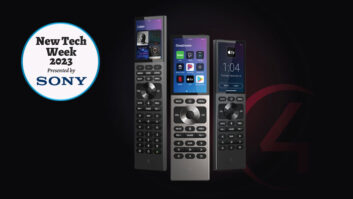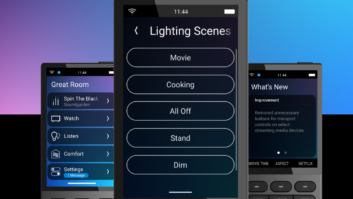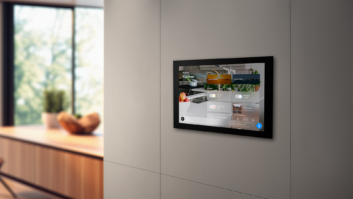
Middle Atlantic’s RackLink remote power management system comes with a built-in temperature sensor.
Remote management products are one of the best examples of the proverbial “win-win” for both custom integrators and their customers. They’re designed to give a homeowner extra peace of mind that if something goes wrong with their home automation system, a professional can immediately address it from anywhere in the world. In turn, these products can save a professional integrator time and money and provide potential service revenue opportunities.
While these potential benefits are clear, the profit from them is less tangible. In most cases, remote management tools are more of a money saver than a profit generator. For instance, not having to roll a truck every time a third-party cable box craps out or needs a reboot saves valuable time and money.

Kaleidescape online support monitors equipment and notifies the dealer if there’s an issue, and allows dealers to check-in on the systems themselves too.
“One of the biggest opportunities for failure on an AV project is the service provider’s interface (cable box, satellite receiver, modem, etc.),” noted Sean Weiner, president of Starr Systems Design in Baltimore. “Most of these devices do not provide any kind of advanced connectivity with our control system, so when they have problems, we have no notification. We use the power control products to perform reboots of these devices by effectively removing power from the device.
“We’re saving hundreds of dollars by not rolling trucks to perform these simple resets, and we’re improving client satisfaction by resolving issues quickly,” Weiner said.
But that’s not the only financial benefit for integrators. “It’s more than saving money by not rolling a truck,” said Jack Gattinella, customer service manager for Maverick Integration in Bedford, NH. “It’s the fact that our clients feel comfortable that if something goes down or needs to be rebooted, they know that we are a phone call/ email away from solving the problem.”
Gattinella noted that remote management products allow them to test connectivity, as well as perform reboots.

SurgeX’s Axess Elite, which allows dealers to auto-ping eight IP devices, as well as nest or sequence triggered events together.
Tom Gunderson, operations director at The Little Guys, in Mokena, IL, also cited preventative maintenance and the ability to make changes or add services to the list of advantages. One example Gunderson said was, “if a specialized piece of equipment needs a small configuration change that is outside of the installer’s ability, a specialist at the office can login remotely to make that change,” additionally freeing them up for other jobs.
Temperature is another issue remote management can help address. “We set up email alerts that help us monitor the temperature of each system,” said Tom Vaughn, of Concept Electronics in Austin, TX. “If the temperature in the rack is too high, then we get an email alerting me of the project name, device name, real-time temperature, and the time of the event. We can setup a secondary fan that’s activated off of this temperature event. Once the temperature returns to normal, the fan automatically turns off, and I get another email telling me the temperature is in a safe condition. If I don’t get a safe condition notification, then I can contact the client to find out if there is an issue with the system.”
Vaughn takes full advantage of “almost every feature available on a remote management product,” including email notification, power status logging, and custom integration.

The Access Networks Foundation networking solution offers a host of routing and switching features combined with a centrally managed, self-healing wireless solution.

Homeowners enjoy the remote access the Nest digital thermostat affords them.

Panamax’s BlueBOLT technology provides secure, hosted IP system control to connected equipment.

The ihiji remote monitoring system not only manages the network, but has extended control system and power product integration.
Concept Electronics uses Middle Atlantic’s RackLink product, which comes with a built-in temperature sensor, or SurgeX’s Axess Elite, which has a temperature sensor sold separately, as well as some advantages over the RackLink, “but each device is priced accordingly,” Vaughn noted.
“The Elite also lets us auto-ping eight IP devices…but the most powerful function of the Axess Elite is the ability to nest or sequence triggered events together,” Vaughn said. “We can take any incoming trigger event and match it to any possible output action the device can produce.”
Panamax’s BlueBolt remote power management technology is another popular solution among integrators, as well as PS Audio and Nuage Nine. Maverick Integration’s Gattinella mentioned that solutions from Kaleidescape and Access Networks monitor their equipment and notify the dealer if there’s an issue. Both allow dealers to monitor the systems themselves, too.
Starr Systems’ Weiner reported success using the ihiji remote monitoring system, which not only manages the network, but is also linked to other manufacturers (Crestron, AMX, Control4, and Savant) for extended control system integration and power product integration (BlueBolt, PS Audio, SnapAV, SurgeX, Tripp Lite, and others.)
Scott Dobrydney, assistant engineer for New York City-based Old Cove Integrators noted the Nest digital thermostat for its remote management capabilities. This is primarily a tool homeowners themselves enjoy accessing remotely, he noted. “Since a number of our customers are busy business owners and execs who are constantly commuting between work in the city and home in the suburbs, they can remotely heat and cool their homes with the Nest app and have the temperature be just right when they return,” he explained.
The Little Guys sells Control4’s 4Sight, a subscription to a bundle of secure, premium internet services that includes remote home monitoring and control, remote programming and support, as well as customized email notifications. Rick Kalm, of cyberManor in Los Gatos, CA, uses Control4’s my.control4.com, an assortment of complementary internet services that the system supports; it includes software updates, music and movie identification, and TV channel and radio station lineups.
To Bill or Not to Bill
Benefits aside, the question remains for many integrators as to how to bill clients for something you didn’t have to go anywhere to fix. There are various approaches to this dilemma.
For Maverick Integration‘s Gattinella, “Most clients don’t like to have a reoccurring bill sent to them every month, so we have always built in the cost for yearly billing and or lifetime accounts,” he said.
cyberManor sells its work conducted via remote management as a service. “Most customers are billed for service on a time and materials basis, with a few on a ‘retainer’ basis,” Kalm said. “It can be pointed out to the customer that they will usually save money with this approach. And I can potentially have more billable time available to increase my revenue.”
Starr Systems includes remote management services in its service and maintenance agreements, informing clients from the start what they’ll be paying for this added benefit. This way, they profit from selling the product itself, as well as monthly fees they collect for monitoring the systems.
The Little Guys just recently began offering annual remote support plans for the control systems that they sell, covering basic remote troubleshooting and minor changes to system configuration, Gunderson said. They are still ironing out the details of these plans, but they, “intend on expanding those types of services to network support and other avenues, and possibly a different reduced labor rate for remote support type jobs, like media management or major configuration changes,” he explained. “The goal of these offerings is to set the expectations with our clients that even though we may not be coming to their location to do a job, our time is not free, and they will be paying for our services.”
Not every installer insists on charging for these services. Vaughn, of Concept Electronics, noted that most of the issues they deal with that require remote management, can be resolved in 15-20 minutes over the phone. “We don’t charge our clients for this service,” he said. “We want our clients to call us if something in their home isn’t working correctly.”
Lindsey Adler is associate editor for Residential Systems, Systems Contractor News, and Healthcare AV.






